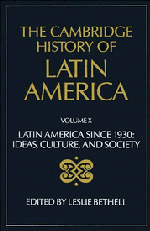Book contents
- Frontmatter
- 1 The multiverse of Latin American identity, c. 1920–c. 1970
- 2 Latin American narrative since c. 1920
- 3 Latin American poetry, c. 1920–1950
- 4 Latin American poetry since 1950
- 5 Indigenous literatures and cultures in twentieth-century Latin America
- 6 Latin American music, c. 1920—c. 1980
- 7 Latin American architecture, c. 1920–c. 1980
- 8 Latin American art since c. 1920
- 9 Latin American cinema
- 10 Latin American broadcasting
- Bibliographical essays
- References
6 - Latin American music, c. 1920—c. 1980
Published online by Cambridge University Press: 28 March 2008
- Frontmatter
- 1 The multiverse of Latin American identity, c. 1920–c. 1970
- 2 Latin American narrative since c. 1920
- 3 Latin American poetry, c. 1920–1950
- 4 Latin American poetry since 1950
- 5 Indigenous literatures and cultures in twentieth-century Latin America
- 6 Latin American music, c. 1920—c. 1980
- 7 Latin American architecture, c. 1920–c. 1980
- 8 Latin American art since c. 1920
- 9 Latin American cinema
- 10 Latin American broadcasting
- Bibliographical essays
- References
Summary
introduction
In general terms, the history of Latin American art-music composition in the twentieth century begins with a period of nationalist assertion, with neo-Romantic and neo-classical countercurrents, followed by a period of openly experimental tendencies. These trends occurred at times concurrently in the various Latin American republics, but musical nationalism appeared above all from the 1920s to the 1950s, neo-classicism and other neo-tonal aesthetic orientations at various times from the 1930s, while experimentalism and the avant-garde in music prevailed from the early 1960s. The output of Latin American composers was considerable, revealing a wide compositional diversity, according to historical period, geographical location and special socio-cultural conditions and circumstances. There was at the same time a significant development of music professionalism, supported by professional associations and by institutions of learning, including the national conservatories inherited from the nineteenth century and, from the 1930s, some state and private universities. A number of opera houses were erected or reconstructed from the beginning of the century, and national symphony orchestras emerged in the major countries of the continent in the 1920s and 1930s.
Historically the art music of twentieth-century Latin America had its antecedents in the colonial period and, above all, in the nineteenth century when numerous elements of the great European classical tradition were implanted in the continent. Following the wars of independence, several of the emerging nations established national music institutions. They were, however, dominated by foreign professionals and visiting virtuosi, especially in the latter part of the century.
- Type
- Chapter
- Information
- The Cambridge History of Latin America , pp. 307 - 364Publisher: Cambridge University PressPrint publication year: 1995
References
- 1
- Cited by



